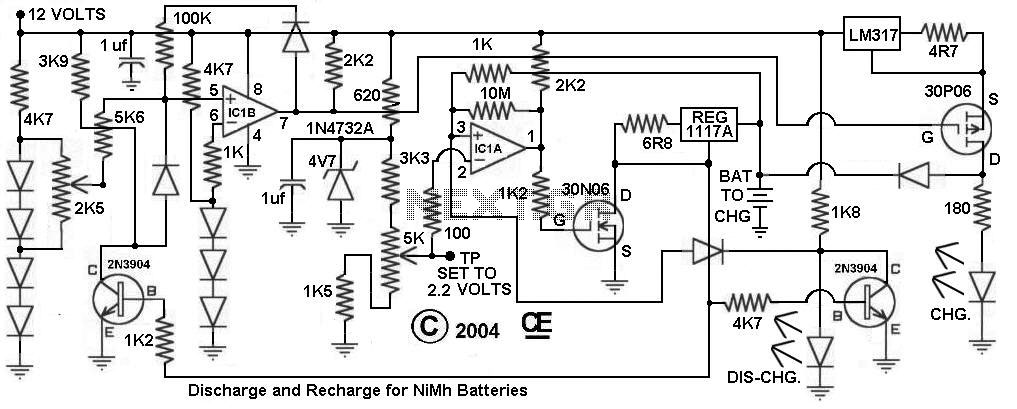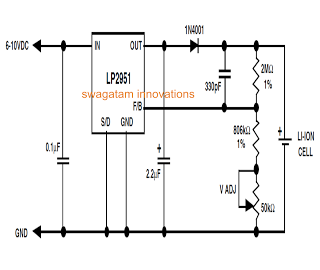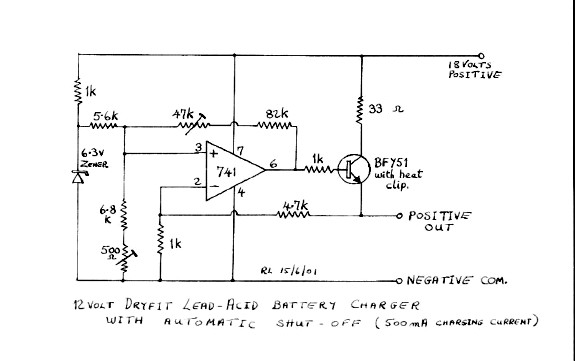
NiMH / Nicad Charger

I specifically designed this circuit to charge 2 batteries for my digital cameras, but it can be modified to charge 3, 4, 5, or more cells. However, it will not work with only one cell as that voltage is too low for even this LDR discharge regulator. If you decide to always charge 4 or more batteries, the REG1117A could be replaced with an LM317. But with only two cells, this will not work. It is recommended to set the discharge down to 1.1 volts per cell at a rate of 1/10 capacity. This prevents any memory from occurring. Therefore, on an 1800 mAh battery, the discharge current would be 180 mA. This is a slow process and can take many hours, depending on the charge remaining in the battery.
Discharging these types of batteries at a higher rate is not recommended and can cause damage. A proper discharge and recharge takes time, but it is well worth it.
Additionally, in my tests, I have found that the 1-hour quick charge does not produce as good of results as a 4-hour charge. But that choice is yours.
The circuit designed for charging multiple batteries utilizes a linear voltage regulator, specifically the REG1117A or LM317, depending on the number of cells in use. The circuit architecture includes a power source connected to the input of the voltage regulator, which is responsible for maintaining a stable output voltage suitable for charging the batteries.
When configuring the circuit for two batteries, the output voltage from the regulator must be adjusted to match the combined voltage of the two cells in series. For configurations with more than two cells, the regulator can be replaced with the LM317, which allows for a higher output current and better efficiency in charging multiple cells.
The discharge management is critical for battery longevity. Setting the discharge threshold to 1.1 volts per cell ensures that the batteries do not enter a deep discharge state, which can lead to reduced capacity and potential damage. The recommended discharge current of 180 mA for an 1800 mAh battery is calculated based on the 1/10 capacity guideline, ensuring a slow and safe discharge process.
The charging process is time-sensitive; while a quick charge may seem convenient, it often results in suboptimal battery performance compared to slower, more thorough charging methods, such as the recommended 4-hour charge.
For practical implementation, the circuit should include indicators to show the charging status and possibly a timer to manage the charging duration effectively. The use of multiple sets of batteries, as mentioned, allows for continuous operation while ensuring that each set is properly cycled through charging and discharging phases. This approach not only maximizes the usability of the batteries but also helps in maintaining their health over time.I Specifically Designed this circuit to charge 2 Batteries for my Digital Cameras, but it can be modified to charge 3, 4, 5 or more cell. However, It will Not Work with only One Cell as that voltage is too low for even this LDR Discharge Regulator.
If you decide to Always charge 4 or more batteries, the REG1117A could be replaced with an LM317. But with only Two cell, this will not work. It is Recommended to set the discharge, Down to 1.1 volts per cell at a rate of 1/10 capacity. This Prevents any Memory from occuring. Therefore on an 1800 mAH battery, the Discharge current would be 180 mA. This is A SLOW PROCESS, And can take MANY HOURS, depending on the charge remaining in the battery. Discharging these types of batteries at a higher rate will Not Recommended and "Can Cause Damage". A Proper dis-Charge and Re-Charge takes Time, But it is Well Worth it. Additionally in my tests: I have found that the 1 Hour Quick Charge, does not produce as good of results as a 4 hour Charge. But that choice is yours. I use 3 sets of batteries, Each set Numbered and Alternating them is not a problem. 🔗 External reference
Discharging these types of batteries at a higher rate is not recommended and can cause damage. A proper discharge and recharge takes time, but it is well worth it.
Additionally, in my tests, I have found that the 1-hour quick charge does not produce as good of results as a 4-hour charge. But that choice is yours.
The circuit designed for charging multiple batteries utilizes a linear voltage regulator, specifically the REG1117A or LM317, depending on the number of cells in use. The circuit architecture includes a power source connected to the input of the voltage regulator, which is responsible for maintaining a stable output voltage suitable for charging the batteries.
When configuring the circuit for two batteries, the output voltage from the regulator must be adjusted to match the combined voltage of the two cells in series. For configurations with more than two cells, the regulator can be replaced with the LM317, which allows for a higher output current and better efficiency in charging multiple cells.
The discharge management is critical for battery longevity. Setting the discharge threshold to 1.1 volts per cell ensures that the batteries do not enter a deep discharge state, which can lead to reduced capacity and potential damage. The recommended discharge current of 180 mA for an 1800 mAh battery is calculated based on the 1/10 capacity guideline, ensuring a slow and safe discharge process.
The charging process is time-sensitive; while a quick charge may seem convenient, it often results in suboptimal battery performance compared to slower, more thorough charging methods, such as the recommended 4-hour charge.
For practical implementation, the circuit should include indicators to show the charging status and possibly a timer to manage the charging duration effectively. The use of multiple sets of batteries, as mentioned, allows for continuous operation while ensuring that each set is properly cycled through charging and discharging phases. This approach not only maximizes the usability of the batteries but also helps in maintaining their health over time.I Specifically Designed this circuit to charge 2 Batteries for my Digital Cameras, but it can be modified to charge 3, 4, 5 or more cell. However, It will Not Work with only One Cell as that voltage is too low for even this LDR Discharge Regulator.
If you decide to Always charge 4 or more batteries, the REG1117A could be replaced with an LM317. But with only Two cell, this will not work. It is Recommended to set the discharge, Down to 1.1 volts per cell at a rate of 1/10 capacity. This Prevents any Memory from occuring. Therefore on an 1800 mAH battery, the Discharge current would be 180 mA. This is A SLOW PROCESS, And can take MANY HOURS, depending on the charge remaining in the battery. Discharging these types of batteries at a higher rate will Not Recommended and "Can Cause Damage". A Proper dis-Charge and Re-Charge takes Time, But it is Well Worth it. Additionally in my tests: I have found that the 1 Hour Quick Charge, does not produce as good of results as a 4 hour Charge. But that choice is yours. I use 3 sets of batteries, Each set Numbered and Alternating them is not a problem. 🔗 External reference





